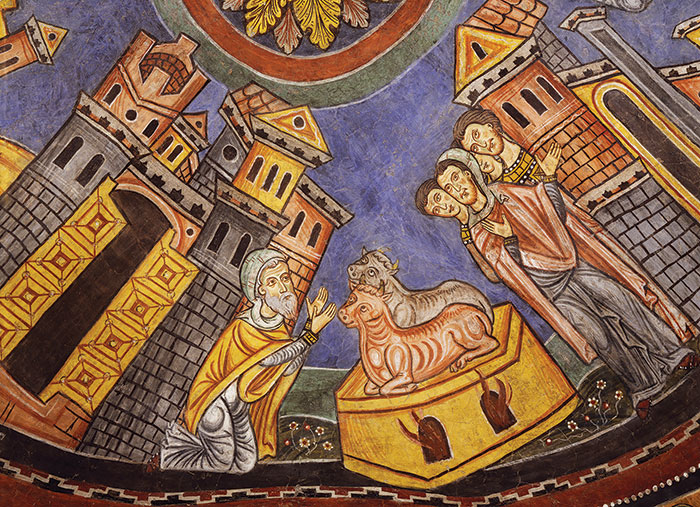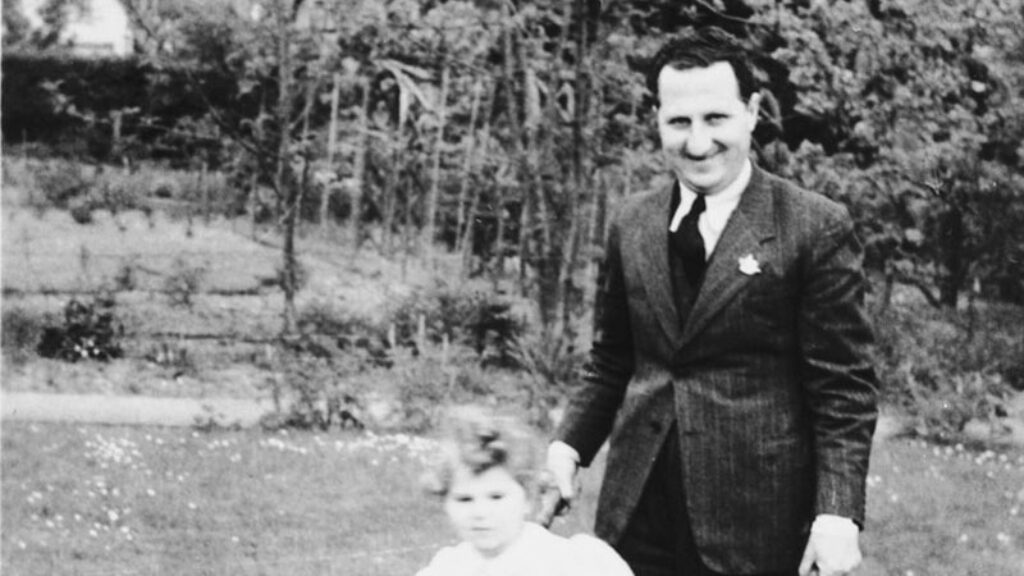Sacrificial Speech
Professor Andrew P. Cohen, the protagonist of Ruby Namdar’s recently translated novel The Ruined House, is a dapper chap with the perfect daily ritual: He exercises consistently, eats healthfully, and leads a seamless life of intellectual and material pleasure. Socially Jewish and crowned with a priestly last name, Cohen is unlettered in Hebrew and so unreligious he barely makes it to synagogue on Yom Kippur. The only temple the good professor frequents is his own gleaming Manhattan apartment, where he showily prepares slabs of filet mignon for fancy dinner parties—a shadowy ancestral memory of sacrificial ritual. In time, however, strange, primitive visions shock Andrew, like a bolt out of the blue. Vexed from 20 centuries of stony sleep, the ancient Jerusalem Temple and its messy sacrificial rite threaten the clean, modern edifice that Andrew—and modern Judaism—worked so hard to build. Then again, maybe the past is not as primitive as we think.
Just a few years after the publication of her Purity, Body, and Self in Early Rabbinic Literature, Mira Balberg has somehow managed to write another path-breaking work on another formidable and arcane section of rabbinic literature—sacrificial law. Like her first monograph, which redescribed and reclaimed the complex and seemingly irrelevant rabbinic rules of purity, Blood for Thought: The Reinvention of Sacrifice in Early Rabbinic Literature shows how an ancient Jewish Temple rite persevered—nay, flourished—for centuries after the Second Temple lay in ruins, its cultic theater shuttered. This was again thanks to the Rabbis of late antiquity, who cut away the melodrama and distilled the sacrificial act into a sparse, almost modernist ritual. In her reconstruction of the rabbinic conception of sacrifice, Balberg challenges the equation of sacrifice with heady romantic cultism and the idea that Judaism as we know it—rabbinic Judaism—is an inherently postsacrificial religion. Along the way, Blood for Thought provokes much thought about the distinction between religious and secular rituals and ancient and contemporary “high priests,” be they Second Temple Jerusalemites or 21st-century New Yorkers.
The book opens with a discussion of another modern Hebrew novel troubled by the tenacity of the Jewish sacrificial rite: “I don’t need a temple,” opines a soldier in Haim Be’er’s The Time of Trimming: “If the minister of education had appointed me as a judge of the Israel Prize, I would give the prize . . . to Titus Vespasian who with the aid of Heaven liberated us once and for all from this nightmare of a slaughterhouse.” This is a polemical version of a common view, uttered often and with conviction among polite company, and it is, to some extent, historically accurate. The destruction of the Jerusalem Temple in 70 C.E. was a watershed moment in Jewish history that shifted the balance of power from the priests toward the Rabbis, so that a public, priestly religion gave way to the more interior forms of worship and study that now characterize Judaism. Guy Stroumsa has gone so far as to describe the Temple’s destruction as the singular moment “that activated the slow—overly slow—transformation of religion to which we owe, among other things, European culture.”

The problem with this theory is that the Rabbis cannot be classified as anti- or postsacrifice. Aside from stray talmudic maxims elevating Torah study over Temple service, the ancient Rabbis devoted an enormous amount of their literary output to the careful study of sacrificial law. Modern scholars have tried to argue away or reinterpret the importance of the evidence, insisting, for example, that the Rabbis were merely trying to appropriate priestly power by teaching the priestly rite or that their goal was to transform physical offerings into prayer-like recitations through study. Alternatively, some have argued that the Rabbis were antiquarians preserving a lost rite before it faded away in the mists of time, or—and this is really an argument of last resort—maybe they were stubbornly, heroically, denying reality by studying sacrificial law as if the Temple continued to exist. Each of these arguments denies the immensity and intensity of the Rabbis’ commitment to animal sacrifice and also the unvexed mood of their writings on the topic.
Balberg’s solution to this problem is so elegant and subtle that, like Poe’s purloined letter, it was missed by generations of scholars. In her account, the Rabbis continued to focus on animal sacrifice long after the Temple’s destruction since, culturally speaking, there never was a complete rupture requiring a reconstruction. Practically, of course, a believer could no longer pick herself up, ascend the Temple Mount, and offer a turtle dove on the altar. But even when the Temple stood in all its glory, sacrifice within its precincts was at best experienced sporadically, as many Jews lived at considerable distance from Jerusalem. Both before—and after—its destruction, the Temple and animal sacrifice held a commanding presence in Jewish life and imagination, and were ceaselessly invoked in prayer, art, and religious study. If decades after the ruin of Jerusalem the ancient Jewish historian Flavius Josephus could still write in the present tense “our slaughter of tame animals for sacrifices . . . is common to us and to all other men,” then rabbis living a few decades later could legitimately lay down the “order of the sacrifice” in real time. Moreover, the distinction between ritual sacrifice to the Deity and kosher slaughter for regular meals was not always clear. Professor Cohen’s dinner guests were onto something when they perceived “his single-minded intensity” as he carved a roast, like “an avatar of an ancient hunter or tribal shaman charged with sacrificing to the gods.”
Sacrifice held the interest of not only the late ancient Rabbis. It has also beguiled well-known modern anthropologists, historians of religion, and Jewish studies scholars from Marcel Mauss and René Girard to Moshe Halbertal. In trying to get to the core of the sacrificial act, these theorists of sacrifice understand it as communication, premeditated violence, or pious devotion. In so doing, they have tended to focus on specific ritual actions to support their theses, such as entering and exiting sacred space (communication), the slaughter of the animal (violence), or its dedication (devotion), while ignoring other parts of the sacrificial process.
Blood for Thought’s main contribution is to show how despite the Rabbis’ preservation of animal sacrifice as an ongoing cultural paradigm, there was also a shift away from the past. The Rabbis may not have revived sacrifice, but they did thoroughly reinvent it by excising anything “sacrificial”—that is, giving something up for a higher entity—from Jewish sacrifice. They consistently downplayed the roles of human giver and divine recipient by rendering emotionally charged moments like the laying of hands on the animal and the sacred consumption of the flesh on the altar as ritually inconsequential. Even the violent spectacle of the sacred butchery was de-emphasized. What remained was a stark, entirely procedural act, termed “the work of blood,” consisting of precise movements and the perfect concentration of nameless priests, wherein the chief “drama”—if we can call it such—was the flawless fulfillment of ritual obligations which almost miraculously transformed parts of the slayed animal from forbidden to permitted.
Balberg shows how the Rabbis addressed issues that had been raised earlier but took on a new importance during late antiquity, the period stretching roughly from Rome’s crisis of empire until the Muslim conquests, which saw many religious transformations, including the “end of sacrifice” throughout the Mediterranean world. In response to the age-old challenge of why an omnipotent god would require sacrifices to begin with, some pagan writers enthusiastically embraced the abandonment of sacrifices. Others, like the Church Father Clement, developed an old allegorical understanding that rendered the physical offerings moot. For their part, the Rabbis responded that sacrifices remained consequential, not in order to fulfill a divine appetite for flesh, but rather to communicate a central halakhic value—that fulfilling mitzvot fastidiously is, as Ecclesiastes put it, “the sum of Man.”
Balberg is astoundingly erudite and unfailingly interesting, but, like most contemporary works of academic Jewish studies, Blood for Thought does not address contemporary Jews as much as it could, nor does it engage with traditional rabbinic scholarship. Had Balberg written a longer, different book, she might have traced more recent reinventions of rabbinic sacrifice. One prominent example is the role this highly abstract discourse played in the development of the Lithuanian analytical school—a trend studied by the Lithuanian-born Israeli Supreme Court judge Moshe Zilberg, who argued that it provided a valuable proving ground for a form of Jewish legal reasoning that could be adapted to modern legal discourse. Opposing Eastern European schools of Talmud study rejected this focus and considered the Lithuanian lamdanim lazy in their preference for the abstract, impractical discourse of sacrifice. The late, leading haredi rosh yeshiva Eliezer Menachem Shach liked to quote Pharaoh’s criticism of the Israelites in this connection: “You are weak, weak! That is why you say, ‘Let us go and sacrifice to the LORD’” (Ex. 5:17).
Although it goes against the standards of academic dispassion, it would have been interesting if Blood for Thought had included some reflection on the potential meaning of sacrifice for contemporary Judaism, including its non-Orthodox varieties. One of the most interesting characters in Namdar’s The Ruined House is Rabbi Abby Rosenthal, who devotes the Yom Kippur sermon in her Reform congregation to the day’s sacrifices—the “theatrical performance staged every year” in ancient Jerusalem. Rather than reacting with drooping eyelids and stolen snores, the congregation is enthralled as Rabbi Rosenthal relates her excitement upon rediscovering the details of the sacrificial rite, which her rationalist predecessors had rejected:
“Our text for today was deleted from the prayer books that you and I grew up with by the nineteenth century. This year I rediscovered it. Its aesthetics, structure, texture are as fascinating as are its contents. It’s old, strange, fascinating, inspiring. It moves me greatly to share it with you. It’s called”— she pronounced the words in Hebrew, in a deep, musical, guttural voice—“Seder ha-Avodah, Order of the Ritual.”
Comments
You must log in to comment Log In
Suggested Reading
Why There Is No Jewish Narnia
So why don’t Jews write more fantasy literature? And a different, deeper but related question: why are there no works of modern fantasy that are profoundly Jewish in the way that, say, The Lion, the Witch, and the Wardrobe is Christian?
All the Good Things of Spain
The greatest Hebrew poet gets the English bio he deserves.
A Normal Israel?
Zionism has long based its claim to sovereignty on the universal right to national self-determination, and the phrase “like all other nations” has been incorporated into Israel’s Declaration of Independence, yet the goal of “normalization” has proven to be much more complicated than most early Zionists had thought.

Family Secrets
“We beam with pleasure. We are in a place where our name is known. For both of us, this is astonishing. An absolute first.”
David Matar
Shai
Thank you for your well-crafted review. I hope to read the book in an academic library, since it's a bit pricey as far as purchase goes. I wonder whether Mira discusses the innovative, even revolutionary Rabbinic concept of "pigul" where a temple sacrifice can be invalidated just by the priest having the wrong intentions or thoughts while performing the initial actions of the sacrificial rite. Needless to say, there is no explicit mention of such a disqualification anywhere in the Biblical text, and the Rabbis read this entire halakhic category into some unrelated verses. To me this is the ultimate example of Rabbinic recasting and rethinking of the sacrificial laws, where they shift the emphasis onto the inner thought processes of participants in the rites, rather than on the actions themselves. That point would be the centerpiece of the book I would write about Kodshim.